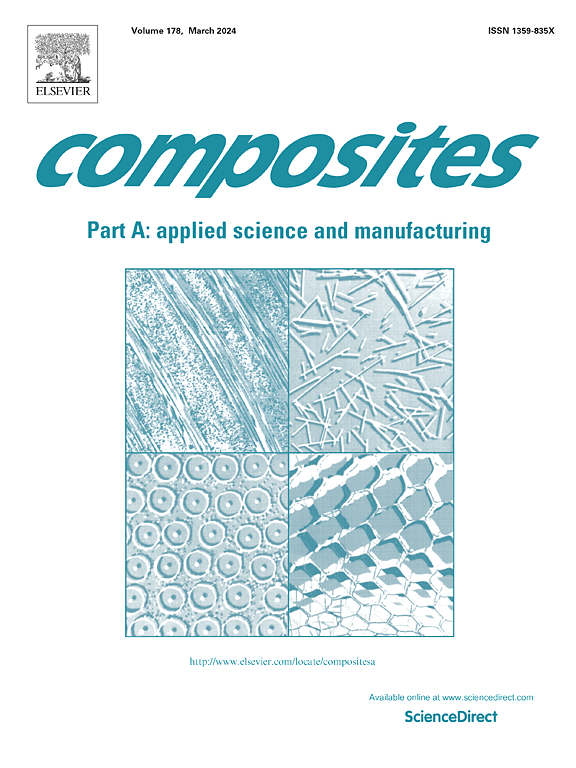Sustainably designed SiO2/polyarylate nanofiber composite aerogels for advanced thermo-acoustic insulation
IF 8.1
2区 材料科学
Q1 ENGINEERING, MANUFACTURING
Composites Part A: Applied Science and Manufacturing
Pub Date : 2025-05-06
DOI:10.1016/j.compositesa.2025.109014
引用次数: 0
Abstract
Nanofiber aerogels, characterized by their low density, high porosity, and robust mechanical properties, have emerged as promising candidates in thermo-acoustic insulation domain. Nevertheless, these materials frequently encounter challenges related to inadequate insulation synergy, complex production processes, and environmental issues. In this study, we engineered a novel nanofiber composite aerogel (NCA) composed of polyarylate (PAR) nanofibers and silica hollow microspheres (SiO2 HMs), utilizing straightforward freeze-drying and thermal treatment methodology. The PAR nanofibers establish a porous network, while the SiO2 HMs reduce thermal conductivity and enhance sound absorption. Furthermore, the thermoplastic nature of PAR facilitates easy welding and recycling. Optimal performance of the SiO2/PAR NCAs is achieved at a composition of 30 wt% SiO2 HMs, yielding a thermal conductivity of 0.018 W m−1 K−1, which is merely 24 % of that of commercial PU foams. The composite exhibits an average sound absorption coefficient of 0.7048 and a noise reduction coefficient of 0.4276. Under thermal conditions of 100 °C, the surface temperature increases by only 22.5 °C, while at −4.5 °C, it decreases by 6.6 °C, resulting in a noise reduction of 14.3 dB. In contrast, commercial PU foam shows a 47.8 °C increase at 100 °C and an 18.4 °C decrease at −4.5 °C, with only 1.1 dB noise reduction.
可持续设计的SiO2/聚芳酯纳米纤维复合气凝胶,用于先进的热声隔热
纳米纤维气凝胶以其低密度、高孔隙率和坚固的力学性能,成为热声绝缘领域的一个有前途的候选材料。然而,这些材料经常遇到与绝缘协同作用不足,复杂的生产过程和环境问题相关的挑战。在这项研究中,我们设计了一种新型的纳米纤维复合气凝胶(NCA),由聚芳酯(PAR)纳米纤维和二氧化硅空心微球(SiO2 HMs)组成,利用直接的冷冻干燥和热处理方法。PAR纳米纤维形成了多孔网络,而SiO2纳米纤维降低了热导率,增强了吸声能力。此外,PAR的热塑性特性便于焊接和回收。SiO2/PAR NCAs的最佳性能是在SiO2 HMs含量为30 wt%时实现的,其导热系数为0.018 W m−1 K−1,仅为商用PU泡沫的24%。该复合材料的平均吸声系数为0.7048,降噪系数为0.4276。在100°C的热条件下,表面温度仅升高22.5°C,而在- 4.5°C时,表面温度降低6.6°C,噪声降低14.3 dB。相比之下,商用PU泡沫在100°C时温度升高47.8°C,在- 4.5°C时温度降低18.4°C,噪声仅降低1.1 dB。
本文章由计算机程序翻译,如有差异,请以英文原文为准。
求助全文
约1分钟内获得全文
求助全文
来源期刊

Composites Part A: Applied Science and Manufacturing
工程技术-材料科学:复合
CiteScore
15.20
自引率
5.70%
发文量
492
审稿时长
30 days
期刊介绍:
Composites Part A: Applied Science and Manufacturing is a comprehensive journal that publishes original research papers, review articles, case studies, short communications, and letters covering various aspects of composite materials science and technology. This includes fibrous and particulate reinforcements in polymeric, metallic, and ceramic matrices, as well as 'natural' composites like wood and biological materials. The journal addresses topics such as properties, design, and manufacture of reinforcing fibers and particles, novel architectures and concepts, multifunctional composites, advancements in fabrication and processing, manufacturing science, process modeling, experimental mechanics, microstructural characterization, interfaces, prediction and measurement of mechanical, physical, and chemical behavior, and performance in service. Additionally, articles on economic and commercial aspects, design, and case studies are welcomed. All submissions undergo rigorous peer review to ensure they contribute significantly and innovatively, maintaining high standards for content and presentation. The editorial team aims to expedite the review process for prompt publication.
 求助内容:
求助内容: 应助结果提醒方式:
应助结果提醒方式:


